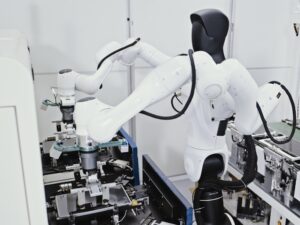Ubergizmo was invited as a media partner for the Future Innovation Tech Expo 2025 (FIX 2025), held from Tuesday, October 21 to Saturday, October 25 in Daegu, South Korea — a city recognized as one of the country’s top robotics and biotechnology hubs. As part of this partnership, Ubergizmo participated in the judging of the FIX Media Awards 2025, a program distinct from the official FIX Innovation Awards 2025 that we also covered during the event.

Eliane Fiolet, Co-founer, Ubergizmo, with the Top 3 winners: Wearcom, LCHP Tech and Wearcom
I was assigned 16 companies to evaluate and meet with during the show, from which I selected my top three. Each participating media outlet conducted a similar evaluation within its own pool of companies, and in total, five other global media partners also selected their top three choices based on their assigned exhibitors. The decision was challenging, as I was genuinely impressed by the sophistication of the technologies and the level of innovation presented across diverse fields. AI, robotics, mobility, and biotech emerged as dominant themes throughout the exhibition.
My key selection criteria were Innovation and Technological Uniqueness, Positive Impact on the World, and Industry Potential.

FIX Global Media Awards 2025, all winners and judges on stage
Among the companies I evaluated, three stood out for their exceptional creativity, vision, and potential to shape the future of their respective industries — Aetech, WEARCOM INC, and LCHP Tech. Corp.
Aetech

Aetech technology description
Aetech earned its place among the top three for its holistic and highly practical approach to waste management automation. The company’s suite of solutions — the AI-powered waste-sorting robot Atron, the high-efficiency automated recycling platform Airo-MRF, and the compact Multi-tron system — demonstrates a clear vision for scalable, real-world deployment. Aetech stands out for applying advanced computer vision and AI models to handle complex waste streams that traditionally require manual labor, improving both accuracy and throughput. Its modular systems can be easily integrated into municipal and private facilities, including multi-use buildings, addressing one of the biggest barriers to adoption: space and cost constraints. By combining sustainability goals with operational efficiency, Aetech bridges the gap between environmental responsibility and industrial practicality — making its innovation not only technically impressive but also globally relevant in the circular economy movement.
WEARCOM INC
WEARCOM impressed me for its groundbreaking dry nanocellulose manufacturing technology, which delivers clean, fast, and highly productive powder production while eliminating the need for water or solvents. This fully dry process — rare in the nanocellulose field — reduces energy use, simplifies manufacturing, and opens the door to scalable, eco-friendly material production. While still at the prototype stage, WEARCOM’s first target applications include replacing medical patches and flexible packaging materials, both of which currently rely on plastic. Standard nanocellulose is already recognized for its high mechanical strength and excellent gas-barrier properties, making it a promising sustainable replacement for plastics in food packaging. I selected this company because the packaging industry is urgently seeking sustainable alternatives to plastics —a multi-billion-dollar global opportunity. WEARCOM’s patented technology positions it at the forefront of the bio-based materials movement, blending environmental responsibility with industrial feasibility and setting a strong foundation for future large-scale impact.
LCHP Tech. Corp.
 LCHP captured my attention for developing a low-cost, high-definition LiDAR system that uses the same optical technology found in an atomic force microscope to achieve high resolution at a fraction of today’s typical LiDAR cost. This approach is unique in the LiDAR industry — none of the major players currently use atomic microscope-based optical methods — giving LCHP a clear technological edge. While still at the prototype stage, this innovation tackles one of the most persistent challenges in autonomous driving and robotics: reducing sensor costs without compromising precision. By adapting advanced microscopy principles to LiDAR design, LCHP could make high-quality 3D sensing practical for a wider range of applications, from industrial robots to smaller agricultural or service vehicles. With a patent pending on this distinctive technology, LCHP stands out as a deep-tech pioneer poised to disrupt a field long dominated by incremental improvements rather than fundamental breakthroughs.
LCHP captured my attention for developing a low-cost, high-definition LiDAR system that uses the same optical technology found in an atomic force microscope to achieve high resolution at a fraction of today’s typical LiDAR cost. This approach is unique in the LiDAR industry — none of the major players currently use atomic microscope-based optical methods — giving LCHP a clear technological edge. While still at the prototype stage, this innovation tackles one of the most persistent challenges in autonomous driving and robotics: reducing sensor costs without compromising precision. By adapting advanced microscopy principles to LiDAR design, LCHP could make high-quality 3D sensing practical for a wider range of applications, from industrial robots to smaller agricultural or service vehicles. With a patent pending on this distinctive technology, LCHP stands out as a deep-tech pioneer poised to disrupt a field long dominated by incremental improvements rather than fundamental breakthroughs.
Honorable Mention

IMsystem Pathfinder-Navi-ST prototype, Piaspace MACS, and Quester hand-tracking glove
A few other companies came very close to making the top three. Quester Inc. stood out with its hand-tracking glove, a precise, responsive interface solution for virtual reality, robotics, and motion-control systems, enabling natural, intuitive human–machine interaction. Piaspace Co., Ltd. presented MACS (Multi-modal AI for Camera Solution), an advanced CCTV analytics system that simultaneously processes video and text data using multimodal AI to interpret complex situations and contextual meaning beyond the reach of conventional visual systems. It can be easily integrated into existing CCTV networks via an AI server (SaaS or on-premise), transforming standard surveillance infrastructure into next-generation multimodal AI-powered platforms capable of precise, real-time anomaly detection. IMsystem Co., Ltd. showcased Pathfinder-Navi-ST, a micro medical robot for precision endovascular intervention, and VasculiX, a biomimetic 3D vascular simulation model that enables advanced research and testing. Each of these companies demonstrated remarkable innovation and vision, further highlighting the exceptional diversity and creativity seen at FIX 2025.
FIX 2025, Global Media Awards – Ubergizmo’s Top 3
, original content from Ubergizmo. Read our Copyrights and terms of use.



